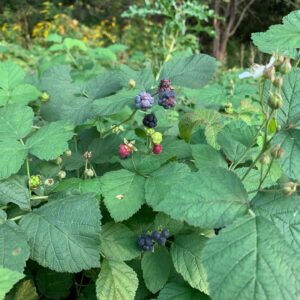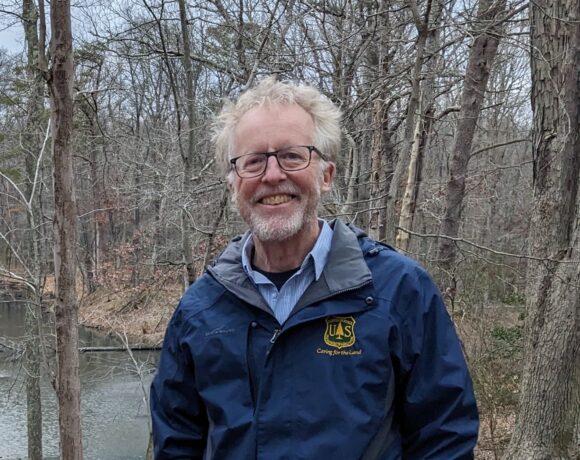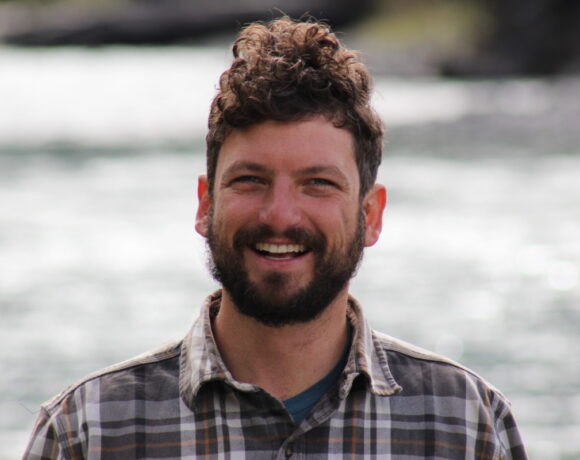This month, NYISRI interviews Dr. Kathryn Amatangelo, Associate Professor at SUNY Brockport, who is currently investigating the genetics and control of European dewberry, mile-a-minute, and Japanese knotweed.
What kinds of questions are you currently asking related to invasive species and their management?

Three invasive species projects in my lab focus on European dewberry, mile-a-minute, and Japanese knotweed. My graduate student Lexie Davis is looking at how prevalent European dewberry is and best methods for control. That project is based at Ganondagan State historic site with collaborators from New York State Office of Parks, Recreation and Historic Preservation. Lexie has an experiment testing different control methods and is also doing some genetic analyses to see if we have just one or two types of invasive dewberry in our region. The second project, which is funded by the New York State Department of Environmental Conservation, is focused on the control and impacts of mile-a-minute. There are two locations of mile-a-minute in our area: one in Geneseo and one in Oakfield. My students and I have been researching and treating those for the past three years. Lastly, we are just starting a project with Cornell Cooperative Extension of Niagara looking at the impacts of Japanese knotweed on invertebrate communities and trying to release a psyllid biocontrol in our region.
Could you dive a little bit more into the details of some of the methods you’re using? How are you going about answering these questions?
Both the dewberry project and mile-a-minute project involve experimental application of different treatments (mechanical, herbicide, and combined treatments) to evaluate which methods are most effective for control. We apply the treatments and compare invasive species abundance before and after treatment over multiple years. In addition, on the dewberry project, we’ve been in collaboration with a researcher at Cornell, Dan Fernando. He is on Lexie’s committee and she’s been working in his lab to extract and then sequence DNA of different populations of dewberry around our region. We initially made observations that the populations in Ganondagan and Brockport seemed different morphologically than the populations in the Finger Lakes and Syracuse. So, we’re testing that hypothesis, and it does look like there may be some genetic differences, where at least one of those two may actually be a hybrid. We still don’t know what it is yet. That’s my first foray into genetics work here at Brockport, which has been really exciting! With the biocontrol project, we’re raising Japanese knotweed in a greenhouse and we get shipments of the psyllid from a group in Oregon. We raise them, keep them in the greenhouse, and then we’re going to release them to see whether or not they survive or negatively impact knotweed. We’re hopeful, but not certain that they’re going to succeed based on previous work in the area, but it’s always worth a second try.

What’s your personal story? How did you get started down this path and what ultimately led you to work with invasive species?
When I was growing up in Michigan, my family would take road trips to National and State Parks. That’s how I learned to love nature, and I got my first ecology lesson at Yellowstone National Park. We were out there not too long after the massive fires that had taken out a large area of forest and what was left was a lot of grass and dead snags. I was horrified; I thought the environment was destroyed by these fires, but somebody that worked at the Park Service explained that fire is natural and an important part of the system. So that was my first in-person connection to science and thinking about how we understand the natural world.
I became really interested in invasive species during my graduate work because I did my dissertation research in Hawaii, where the native understory plants are primarily ferns, whereas the invasive species are often angiosperms. Angiosperms have low concentrations of hard-to-decompose compounds with a lot of nutrients, so the invaders have really changed Hawaiian forests in a lot of ways. One example is Morella faya, which is a nitrogen-fixer, and has majorly changed nutrient dynamics in young forests. There are also invasive grasses which have increased fire regime frequency in areas that shouldn’t really have fire. So, it’s in Hawaii that I really became interested in invasive species.
How does your research relate to the wider field of invasive species management and prevention? How could your methods be adapted for other issues and regions?
One of our current focuses is on early detection and rapid response (EDRR). The idea behind EDRR is that if you don’t get control of an invader when the populations are small and constrained, you’re probably never going to eradicate the species. Eradication is only possible at the very beginning of the invasion curve. After that point, you have to choose whether or not to control it on a site-by-site basis. I think one thing that’s interesting about annual plants, like mile-a-minute with short-lived seeds, is that eradication is more feasible. Knowledge about the ecology an invasive species is important to predict the likelihood of eradication and control. Other species that are pernicious and hard to fully eradicate, like Japanese knotweed or Phragmites, we need to decide if that’s where our resources should go.
The other thing that I’m interested in is this idea of whether invasive species are ‘passengers’ or ‘drivers’ of change. This is a hypothesis that some invasive species become abundant because a site is already disturbed. They would be considered passengers. Other invasive species may be ‘drivers’. They come in, drive change in the system, and they make it much harder to maintain native diversity. We need to evaluate which species have the biggest impacts since those are the ones we should be focusing our control efforts on.
What’s the most important thing about your research that you think invasive species managers and decision makers should know?
My biggest take-away would be that controlling an invasive species at a site is only putting a band-aid on a bigger problem. We need to be thinking about the system holistically. For example, if the site has over-abundant deer or is next to other invaded sites you can’t treat, then control efforts may only have a temporary effect. This is particularly true if you don’t have the resources to plant native species that can prevent future invasion through priority effects.
Controlling invasive species without addressing the reason the invasive species were able to get into that site sets us up for an endless cycle of control and reinvasion.
We need to stop that cycle by getting to the root of the problem, or just commit to continuing that cycle in priority locations that we want to keep pristine.
What do you hope your impact will be in the long-term from your work and from the students carrying on your work?

I don’t think about my legacy in invasive species research very much because I ask questions that are interesting to me and that get students excited. So, if my research also contributes to the broader knowledge of invasive species in our area, that’s wonderful. But I see myself as training people to understand invasive species and bring that knowledge with them to their future jobs. That’s why I do what I do. I guess I don’t see it as coming up with a one-size-fits-all tome of what we should do with invasive species, or how we control invasive species. It’s more of taking every invasive species as an individual and understanding it. Then educating people on how to do those studies, and how to gain that knowledge, so that we can make case-by-case decisions about invasive species.
Is there anything we didn’t cover that you wanted to share with us?
I want to mention how important buy-in from many different stakeholders is to invasive species research and management. Invasive species don’t stay on public land, so we need to be able to communicate the problem to people from a wide variety of backgrounds. That is easiest to do if people are interested in the natural world and appreciate science. There are different ways to do that. One is getting people outside, and that’s what my parents did by taking me to the parks. Another way is through education. I was really lucky because I got take a class in high school called Conservation. That’s what ended up leading me down the path to environmental science. It was that early access to the knowledge and the experience. I think it’s really important that we all strive to make sure that basic understanding of our world and appreciation for science is coming across in education.
For more about Dr. Amatangelo’s research, visit:
https://amatangelolab.weebly.com/
Read more researcher spotlights:













